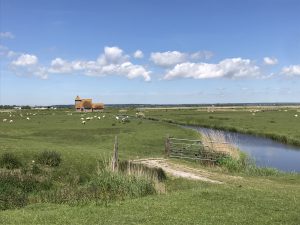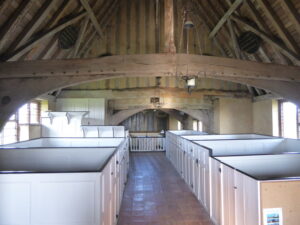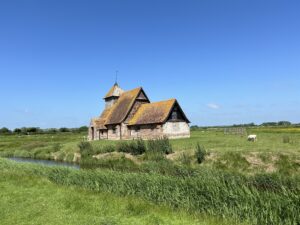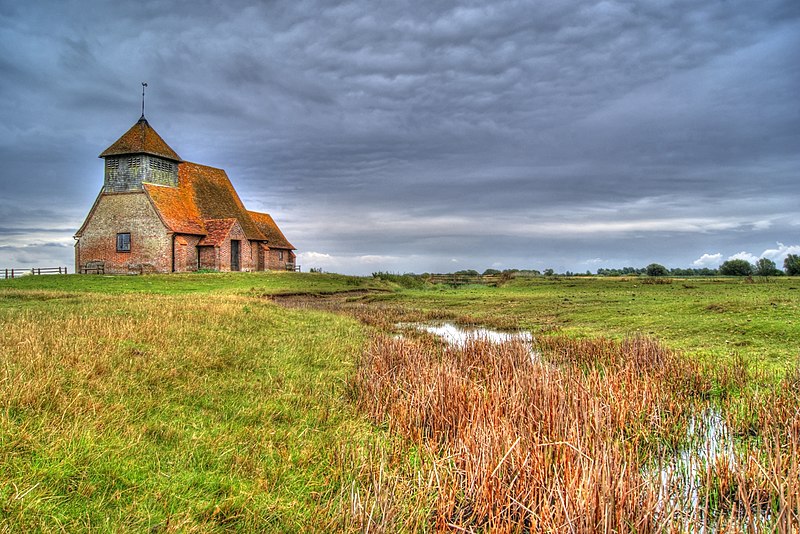Romney Marsh can be a bleak and lonely but beautiful place. Typical of that is the church of St Thomas Becket, sitting alone surrounded by fields and streams, at Fairfield about three miles from Brookland. For many it’s a sight as iconic as St Mary’s Rye. All alone on the Marsh, something to look out for on the rail journey to Ashford.
The story connected to its foundation is that St Thomas Becket, Archbishop of Canterbury from 1162 until his murder in his own cathedral in 1170, was travelling across the marsh and fell into a ditch. As he was going under for the second time he prayed to St Thomas for help. It was at that moment a farmer was passing and pulled him to dry land. So the church was built as a symbol of the archbishop’s gratitude for his salvation.
Around 1200, a very basic building arose made from the traditional materials of lathe and plaster, and probably lime plastered or lime washed inside and out. This early church survived, almost miraculously intact, into the 18th century when bricks were used to enclose the original building and red clay tiles covered the roof. At the same time a new brick foundation was added.

Although now standing isolated, there was at one time a village for the church to serve. It was lost, most probably for the same reason that many English villages were abandoned during the 14th century – the terrible scourge known as the Black Death. It is believed that in just two years between 1348-50 anything up to 45% of the population were killed by the plague.
Plague wasn’t the only killer on Romney Marsh. Stagnant water harbours many nasty bacteria capable of felling a man – or woman. There was also malaria carried by mosquitoes. Malaria, often called ague or marsh fever, was killing people into the 19th century. Indeed, mortality rates on Romney Marsh were about twice as high as in the villages surrounding it. Writing in the late 18th century, Edward Hasted the Kent antiquarian and writer tells us that “the airs and waters” of the marsh were “foul and fatal”. We know from census returns for Fairfield in 1801 that its population was just 49.
Work has been carried out on the church over the centuries. During the early years of the 18th century the south wall was rebuilt with the chancel being reconstructed about 50 years later. At the end of that century a porch was added – no doubt much welcomed as a respite from the cold winds that blow in from the east.
In about 1800 the west and north walls were rebuilt. During 1912-13 almost the entire church was rebuilt because of the dangerous state of many of the medieval timbers. The north wall, bell turret, chancel and roof were all replaced and the foundation once more rebuilt. A causeway was constructed for access during floods. As many of the original materials as could reasonably be salvaged were used during the rebuilding.

The church inside is pure Georgian with white painted box pews, plaques with biblical quotes around the walls and a triple decker pulpit – at the bottom was the clerk’s desk, in the middle the lectern and on top the pulpit for preaching and for giving a bird’s eye view of the congregation. The font is very unusual, indeed unique in Kent, in being seven sided. This is probably a reference to the seven sacraments, or alternatively the seven works of mercy or the seven deadly sins. Such fonts generally date from the 15th century, often paid for by prominent local families trying to ensure the supremacy of the Catholic faith over local superstitions. They are mostly found in East Anglia, where there are at least 22, so to find one in our part of the country is indeed a rarity.
For many years, attending services during winter and spring meant travelling by boat, because of flooding. The 1913 causeway largely solved that problem, but in very wet weather and high water the church can look marooned on its mound. The graveyard has no stones because of the floods. Records show that the last interment was that of Kate Tolhurst, a young domestic servant, who died in 1859.
As one may expect from such a photogenic building and location, the church has appeared in films and on television, especially in productions of Great Expectations as the church where Pip meets Abel Magwitch, the escaped convict. Set just after Christmas 1812, Pip is visiting the graves of his family when he is surprised by ‘”a fearful man, all in coarse grey, with a great iron on his leg. A man with no hat, and with broken shoes, and with an old rag tied round his head. A man who has been soaked in water, and smothered in mud, and lamed by stones, and cut by flints, and stung by nettles, and torn by briars; who limped and shivered, and glared and growled; and whose teeth chattered in his head as he seized me by the chin.” It’s a wonder poor little Pip didn’t just die of fright on the spot! The actual church that inspired Dickens was St James’s at Cooling, also in Kent.

Image Credits: Wikimedia Commons https://commons.wikimedia.org/wiki/File:Fairfield_Church.jpg CC https://creativecommons.org/licenses/by-sa/3.0/, Nick Forman , Geograph/Marathon https://www.geograph.org.uk/photo/6164203 CC https://creativecommons.org/licenses/by-sa/2.0/, James Stewart .




There is no evidence of a village at Fairfield, nor is it clear that the surround was ever a graveyard. It surmised that the motive for building was to serve isolated farms. That is also probably true of the church at Snave, on the Marsh – probably the actual loneliest church on Romney Marsh. When the BBC’s South East Today came to film at Snave in 2019, reporter Ian Palmer took an hour and a half to find the church.
Nick Hudd (ex-Chairman, Romney Marsh Historic Churches Trust)
This is very interesting and perhaps shows how effective is modern research. I found references to a ‘lost’ village at Fairfield in documents from 1588, 1710 and 1799, with the most recent being a University of Hull research project in 1968. I also found a reference, but can’t recall now where it was, that said in the 19th century that ‘only farms remain.’ There was also an Ordnance Survey map reference to a lost village.
I went onto YouTube to watch Pip in the graveyard. Sorry to say it’s not the same church. Maybe a different version to the original.
It’s the 2011 version.
I spent my childhood at Fairfield and was baptised, confirmed and married at St Thomas Becket. The first record of the church was at a visitation of 1294 when it was in poor repair and the priest was criticised for allowing a woman to serve at the altar. The church stands at the very furthest extent of St Thomas Inning recovered from the sea during the 13th Century by the monks of Christchurch, Canterbury. I believe the church was built to give thanks for the completion of what was a very considerable achievement for the time. The seawall they built still exists to the north and west of the church.
I love this church. When I was a child in the ’80s I remember being told by my father that it was known locally as “Becket’s Barn” because of its unusual appearance. He is Kent born and bred but from the Weald not Romney Marsh, so I’d be interested to know if anyone more local has also heard it called by that name in the past?
Becket Barn was the name of the nearest farm (Where you collect the church key). The 16th Century barn still exists though now it is a private house and the farm is called Becket Farm.
Fascinating, thank you!
Beautiful Church, fantastic article, had the most fabulous walk; discovery of the church and history lesson. Filled my heart with its beauty, thank you.
I believe – though details are yet to be confirmed – that this will be one of the four churches visited on this year’s Romney March Churches Coach Tour as part of Rye Arts Festival in September.